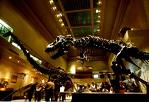Smithsonian Institution of Natural History
Homepage > National History Museums - Smithsonian Institution
The Smithsonian Institution was established in 1846 by James Smithson. It is located in Washington DC, in the United States of America. It contains almost 50 million fossil specimens, held in 450 separate collections.
There are examples of late Jurassic dinosaurs such as Allosaurus, Stegosaurus, Ceratosaurus, and Diplodocus, collected from the Morrison formation in Wyoming and from various sites in Colorado. The collection also features many skulls of Triceratops found by the famous dinosaur Hunter John Bell Hatcher from the Late Cretaceous deposits of Lance Creek, Wyoming.
 Late
Cretaceous dinosaurs were systematically collected under the direction
of Charles Whitney Gilmore, these specimens were from New Mexico and Montana.
Gilmore's early finds in northern Montana included the horned dinosaur
Brachyceratops as well as bone beds that contain juvenile hadrosaurids
and many other kinds of vertebrates.
Late
Cretaceous dinosaurs were systematically collected under the direction
of Charles Whitney Gilmore, these specimens were from New Mexico and Montana.
Gilmore's early finds in northern Montana included the horned dinosaur
Brachyceratops as well as bone beds that contain juvenile hadrosaurids
and many other kinds of vertebrates.
Gilmour was one of the most productive scientists of the 20th century. During his work he described the nearly complete skeleton of Apatosaurus, first located by Earl Douglas in 1909, which was critical to the forming of the Dinosaur National Monument in Utah. During the 1920s and the 1930s, the Smithsonian Institute work the sites in this area extracting many fine dinosaur specimens.
During the 1940s the Smithsonian institution have become home to one of the largest collection of dinosaurs in the world. The museum's collection of dinosaur type specimens contains over 40 named species. Many of the earlier specimens, though, have since been dropped as valid species names or recognize as belonging to other known species.
 Some
of the museum's most important specimens are the skeletons of Alamosaurus
sanjuanensis, Stegosaurus stenops, Brachyceratops montanus, Edmontosaurus
annectens, Styracosaurus ovatus, and Thescelosaurus neglectus.
Some
of the museum's most important specimens are the skeletons of Alamosaurus
sanjuanensis, Stegosaurus stenops, Brachyceratops montanus, Edmontosaurus
annectens, Styracosaurus ovatus, and Thescelosaurus neglectus.
Several mounted dinosaur skeletons which contain more than 50% of original material make up the permanent exhibitions of the Smithsonian's Natural History Museum. Some of these exhibits include Albertosaurus, Allosaurus, Camarasaurus, DIplodocus, Ceratosaurus, Corythosaurus, Edmontosaurus, Stegosaurus, and Triceratops.
Other interesting specimens on display includes the skull of Centrosaurus and the cast of Tyrannosaurus skull from the collections of the American Museum of Natural History.
Today, the Department of paleobiology from the Smithsonian Institution is a major research body for all aspects of paleontology.